AGENTS OF FORTUNE
HOW THREE POWER BROKERS ENGINEERED A SECRET GULF BACK CHANNEL—AND REEMERGED TO SHAPE TRUMP’S 2025 PEACE PLAN
By Rob Waldeck
Updated 5:30 p.m. September 15, 2025
New developments in President Donald Trump’s Middle East peace initiative have reactivated a familiar triad: Tom Barrack, Tony Blair, and Jared Kushner. Axios’ Barak Ravid reports that all three have resumed roles in Trump’s post-war strategy for Gaza, the West Bank, Syria, and Lebanon. Late last month, Blair and Kushner briefed Trump directly on Gaza reconstruction plans. Last Monday, Kushner met with Trump’s peace envoy Steve Witkoff and Israeli advisor Ron Dermer—signaling renewed coordination between Trump’s inner circle and Prime Minister Netanyahu’s team.
Tom Barrack, one of President Trump’s oldest confidants, now serves as U.S. Ambassador to Turkey while doubling as Special Envoy to Syria. In that role, he’s facilitated Trump’s rapprochement with Syrian President Ahmed Al-Sharaa, including the rollback of sanctions dating back to the civil war. In early July, Trump handed Barrack the the informal Lebanon brief—tasking him with nudging Beirut toward a pre-deal disarmament of Hezbollah.

Court filings, FAA flight logs, internal emails, and other documents obtained by The (b)(7)(D) reveal that Barrack, Blair, and Kushner were central to a covert 2016 back channel linking Trump’s inner circle to the United Arab Emirates and Saudi Arabia. Through this shadow conduit, the Gulf monarchies pitched a new peace framework—devised by Blair—that bypassed traditional negotiations on the Palestinian question in favor of direct normalization with Israel. The proposal would later crystallize into the 2020 Abraham Accords, in which the UAE and Bahrain formally recognized Israel, reshaping the region’s diplomatic architecture.
Barrack, Blair, and Kushner would later benefit financially from their ties to the Gulf Arab states. In Barrack’s indictment for acting as a foreign agent, federal prosecutors alleged that in 2017 he received $374 million for his newly merged firm, Colony NorthStar, from the UAE’s sovereign wealth funds—Mubadala Investment Company and the Abu Dhabi Investment Authority. Internal documents obtained by The (b)(7)(D) show Colony NorthStar was also pursuing a $200-$300 million investment from Saudi Arabia’s Public Investment Fund. In November 2022, Barrack was acquitted, successfully arguing he was trying to help Trump moderate his stance towards the Arab world.
Kushner established his investment fund, Affinity Partners, in mid-2021. That year, Crown Prince Mohammed bin Salman—controller of Saudi Arabia’s Public Investment Fund—overrode his investment committee’s recommendations and directed a $2 billion investment into Affinity Partners. In 2023, The New York Times reported Kushner received $200 million from one of the UAE’s sovereign wealth funds. By late 2024, Lunate, a UAE asset management firm, and the Qatar Investment Authority invested an additional $1.5 billion. Lunate is tied to the UAE Royal Group, owned by Sheikh Tahnoun bin Zayed, the UAE’s National Security Advisor and brother to President Mohammed bin Zayed, the Ruler of Abu Dhabi. A recent SEC filing for Affinity Partners listed $4.8 billion in investments.
After Trump left office in 2021, Blair continued to profit from his ties to the UAE. In 2024, the Tony Blair Institute for Global Change acknowledged it had performed both pro bono and paid work for the Emirati government. The Institute’s latest accounts reported “a healthy $38 million in cash on hand.” The documents also revealed a regional hub in the UAE and a Saudi subsidiary—Global Change Company for Business Services LLC. The Institute has recently expanded operations in Saudi Arabia, adding new staff.
The return of Blair, Barrack and Kushner to Middle East policy began in early May, when Barrack took up his post in Turkey. Days later, reports indicated that both Kushner and Blair had taken on advisory roles with Steve Witkoff, Trump’s Middle East peace envoy. A July report in the Financial Times linked Blair’s Tony Blair Institute with Boston Consulting Group’s controversial Gaza reconstruction plan.
After this report was posted this morning, the New York Times reported the UAE’s Sheikh Tahnoun bin Zayed, the UAE’s National Security Advisor and brother to UAE President Sheikh Mohammed bin Zayed invested $2 billion in World Liberty Financial, a company owned jointly by the Trump family and Witkoff.
“THERE’S A FOCUS ON THE MIDDLE EAST, BECAUSE THAT’S WHERE THE MONEY IS”
The idea of a peace deal for Israel enabled by Gulf state involvement began with former British Prime Minister Tony Blair. After resigning the post of Prime Minister in June 2007, Blair became the official Envoy for the Quartet, a peacekeeping mechanism representing the interests of the United Nations, the U.S., the European Union, and Russia. As part of his duties as Envoy, Blair interacted regularly with leaders all over the Middle East.
In 2009, Blair launched his advisory firm, Tony Blair Associates. A friend of Blair told The Sunday Times the firm had “been set up to make money from foreign governments and major companies. There's a focus on the Middle East, because that's where the money is.” Later that year, the Sunday Times reported Blair had signed multimillion-dollar contracts to advise both the Kuwaiti government and the UAE’s state-owned Mubadala Investment Fund.
Blair became a regular visitor to Abu Dhabi, the capital of the United Arab Emirates. Reports surfaced that he frequently stayed at the opulent Emirates Palace Hotel. In an interview with Israel Hayom, Blair described UAE President and Abu Dhabi Crown Prince Mohammed bin Zayed as “an exceptional political and leadership talent.”
A 2015 Sunday Telegraph report revealed that the UAE also funded Tony Blair Associates contracts in Serbia, Mongolia, and Colombia. Blair’s simultaneous dealings with governments he was engaging as Envoy for the Quartet drew sharp criticism. By mid-2015, Blair resigned from the role.
After leaving the Quartet, Blair continued working on peace initiatives, but began advancing a new idea: Israel should establish relations with Arab nations as a prelude to a deal with the Palestinians. He outlined this approach in a 2020 interview published in Israel Hayom:
I have thought for a long time that the whole position that you have to have a peace deal first, and then you open up relations between Israel and the Arab world . . . needed to be turned on its head.
In a later interview with Israeli journalist Barak Ravid, Blair said he first presented the idea to Sheikh Mohammed bin Zayed in 2015. He was also discussing the concept with Israeli Prime Minister Netanyahu, who responded enthusiastically.
In late 2015, Blair convened a meeting in London between Yizhak Molcho, a close confidant of Israeli Prime Minister Netanyahu, and UAE minister Sultan al-Jaber. Blair later told Israel Hayom that the London meeting marked the beginning of the Abraham Accords. Molcho and al-Jaber continued their negotiations by phone and held follow-up meetings in Cyprus and Abu Dhabi. At one London meeting, Mohammed bin Zayed met with Molcho personally.
The efforts bore fruit in 2016 when the Emiratis met a key Israeli demand: dropping arrest warrants against 11 Mossad operatives charged in the 2010 killing of a top Hamas leader in the UAE. At a May 2016 press conference, Netanyahu described the strategy as “working with Arab states to reach a real agreement with the Palestinians.”
In March 2016, Trump addressed the America-Israel Political Action Committee at Washington, D.C.’s Verizon Center. He told the audience: “My number-one priority is to dismantle the disastrous deal with Iran.” The JCPOA nuclear agreement, which lifted sanctions in exchange for limits on Iran’s nuclear fuel processing, had drawn sharp criticism across the Middle East. Netanyahu opposed it, and media outlets reported that both the Saudis and Emiratis were also against the deal.
A senior Western non-proliferation official, speaking anonymously to The (b)(7)(D) to discuss sensitive, but non-classified information, said that at the time, the Saudis and Emiratis felt slighted by the Obama administration. The official added that both governments viewed diplomacy as a zero-sum game, and believed that if Iran secured a nuclear deal with the U.S., their own influence in Washington would be diminished.
“THE FIRST OF MANY MEETINGS”
Thomas J. Barrack Jr. and Donald Trump had been friends since competing in New York’s real estate market during the 1980s. Barrack, the son of Lebanese Catholics from Los Angeles, began his career by leveraging his rusty Arabic to represent U.S. construction interests in Saudi Arabia. While in the kingdom, he developed a close relationship with Saudi Prince Turki bin Faisal al-Saud, son of then-King Faisal.
Barrack soon began working as a fixer, linking Western interests to the Saudi royal court. He also cultivated ties in the United Arab Emirates, negotiating an oil lease with Mana al-Otaiba, the UAE’s first Minister of Petroleum and Mineral Resources and father of UAE Ambassador to the U.S., Yousef al-Otaiba.
Barrack, a key Kushner ally, had helped rescue the Kushner Companies’ faltering 666 Fifth Avenue investment in 2010. When Trump encountered GOP delegate resistance in early 2016, Barrack lobbied Ivanka Trump and Kushner to convince Trump to appoint Barrack’s longtime friend Paul Manafort to the campaign, calling him “a genius killer” in an email to the couple.
With Trump publicly opposing the Iran nuclear deal, the UAE grew increasingly interested in the GOP front-runner. Messages obtained by The (b)(7)(D) show Emirati officials decided to use Barrack as a conduit to Trump, opening a back channel through Rashid al-Malik, a former business partner of Barrack.
In late April, over email, al-Malik and Barrack arranged a trip for the real estate magnate to meet UAE Deputy Ruler Sheikh Tahnoun bin Zayed, National Security Advisor and brother to UAE President Sheikh Mohammed bin Zayed. Barrack said he was “very excited” about the meeting. Rashid replied that Tahnoun bin Zayed was “very much focusing on building the right relationships to help the country and he knows ambassadors can’t do much.” Al-Malik called it “the first of many meetings for us with him” and noted that an investment company between Sheikh Tahnoun bin Zayed and Saudi Deputy Crown Prince Mohammed bin Salman would need to be established.
In later emails, al-Malik emphasized Tahnoun bin Zayed’s relationship with Mohammed bin Salman, describing the two as “best friends” who hold ultimate authority in the UAE and Saudi Arabia. In a later email Barrack boasted that “Donald Trump is a thirty-year partner and I have staffed his campaign.”
On May 1, Barrack met in the UAE with Sheikh Tahnoun bin Zayed, the National Security Advisor and brother of Crown Prince Mohammed bin Zayed. FAA records obtained by The (b)(7)(D) show Barrack’s jet departed the Emirates two days later, landing at 9:13 p.m. on May 3rd.
Shortly after, Emirati official Khalifa al-Ghalfi sent Barrack a glowing email, noting that Tahnoun bin Zayed was “satisfied with the meeting.” Barrack then facilitated an introduction between Jared Kushner and UAE Ambassador to the U.S., Yousef al-Otaiba.
On May 9, Rashid al-Malik emailed Barrack, calling him the UAE’s “only channel to the Candidate.” Al-Malik was working to arrange a meeting between Mohammed bin Zayed, his brother Sheikh Tahnoun bin Zayed, Kushner, and Barrack—intended as a precursor to a direct meeting between MBZ and Trump. Barrack forwarded the message to Kushner with a one-word exclamation: “Confidential!
THE MOONLIGHT SONATA
In June 2016, then–Saudi Deputy Crown Prince Mohammed bin Salman (MBS) traveled to the U.S. to repair strained relations between Riyadh and Washington. At the time, MBS was maneuvering to displace his cousin, Crown Prince Mohammed bin Nayef, as heir to King Salman. During a Ramadan dinner at Secretary of State John Kerry’s Georgetown home, MBS—dressed casually—sat at the grand piano and played Beethoven’s Moonlight Sonata. “We were all surprised,” Kerry later said. “Someone had trained him well.”
Behind the scenes, the Saudis were working to secure a meeting with Trump insiders. On June 21, Barrack emailed Ambassador Yousef al-Otaiba, noting that the Saudis were reaching out through a contact at the Blackstone Group to arrange a meeting with Paul Manafort, scheduled for June 23. Trump had recently promoted Manafort to campaign chairman. Barrack told Otaiba that Manafort would take the meeting if the introduction came jointly through the ambassador and Barrack. Otaiba agreed, and early the next morning confirmed that the introduction of Mohammed bin Salman to Trump’s campaign chairman would proceed through Barrack and Otaiba.
NO STOP IN NEWARK
According to emails obtained by The (b)(7)(D), by late July 2016, Barrack and Rashid al-Malik were planning the next step in their outreach to the Trump campaign: a meeting in Morocco involving members of the Saudi royal family, UAE Crown Prince Mohammed bin Zayed, and Trump’s campaign chairman Paul Manafort, acting on behalf of Trump.
The Saudi royal family owned a sprawling compound in Tangiers, complete with medical facilities, two helicopter landing pads, and one hundred black Mercedes sedans reserved for guests of the King. Saudi media reported that King Salman was hosting Mohammed bin Zayed and other members of the UAE leadership at the compound beginning in late July.
On the morning of August 2, 2016, Tom Barrack Jr.’s Gulfstream 550, tail number N284CC, departed Kona, Hawaii for Van Nuys, California. FAA flight records and court documents obtained by The (b)(7)(D) indicate the flight was the first leg of a trip to Morocco. Barrack had arranged to stop in Newark, where Paul Manafort was scheduled to board the jet.
Ten minutes after Barrack’s Gulfstream took off on its first leg to Morocco, Paul Manafort’s calendar showed a 5:30 p.m. Eastern meeting with Donald Trump and Rudy Giuliani at Trump Tower. Later that evening, Manafort headed to another meeting—this one at the Grand Havana Room—with Konstantin Kilimnik, a man later publicly identified by the U.S. intelligence community as a Russian intelligence officer. Kilimnik was closely tied to Russian oligarch Oleg Deripaska.
A little less than five hours after departing Hawaii, Barrack’s Gulfstream touched down in Van Nuys. According to emails obtained by The (b)(7)(D), Barrack spoke with Trump by phone for about an hour after landing. The emails, first reported by The Knows, reveal that the plan had changed between takeoff and touchdown. Minutes after the call, Barrack emailed his Emirati contact and former business partner Rashid al-Malik: “Paul M not joining us!! No stop in Newark.”
Barrack reassured al-Malik that the meeting remained on track despite Manafort’s absence, telling him, “I am empowered to handle all.” He added, “I just spoke with Trump for an hour about this and we decided this was the best method.” Al-Malik responded with surprise, noting that Sheikh Tahnoun bin Zayed Al Nahyan—the UAE National Security Advisor and brother to the Crown Prince—had been planning to bring Saudi Deputy Crown Prince Mohammed bin Salman to the meetings. Barrack promised al-Malik that Manafort would be available for a conference call two days later, on August 4.
The next afternoon, the FAA records show Barrack’s Gulfstream lifted off for the long flight to Ibn Battouta Airport in Tangiers. Fortune had thrust him into the role of Trump’s negotiator with the UAE. Despite Manafort’s absence, Barrack would arrive in Tangiers and represent Trump at the meeting.
THE COURTESAN
The Emiratis were also using Lebanese American fixer George Nader to reach Trump. In the late 1980s and early 1990s, Nader ran a Washington, DC-based magazine, Middle East Insight. During an FBI interview Nader recounted that he secretly worked on behalf of the Clinton administration in a failed attempt to negotiate a peace between Israel and Syria. But Nader hid his own secret. In 1991, he had been convicted in federal court of transporting child pornography in foreign commerce and in 2002, a court in the Czech Republic convicted him of sexually abusing minors.
Nader later resurfaced in Iraq, playing the role of fixer in Iraq for American companies such as military contractor Blackwater. Blackwater owner Erik Prince described Nader to the FBI as “a courtesan” of the Iraqi government.
2018 reporting by Laura Rozen revealed that in October 2012, George Nader traveled to Moscow to backchannel a $4.2 billion arms deal on behalf of Iraqi Prime Minister Nouri al-Maliki. Nader later told FBI investigators that in late 2012 or early 2013, he accompanied Saudi diplomat Prince Bandar bin Sultan to meet Russian President Vladimir Putin in Moscow, as part of a covert effort to strengthen ties between Saudi Arabia and Russia.
Emails obtained by The (b)(7)(D) show that George Nader’s first attempt in the spring of 2016 to reach Trump on behalf of the UAE failed when a meeting with Jared Kushner—arranged through Trump surrogate Walid Phares—was canceled just minutes before it was scheduled to begin.
TRUMP JR. SAID THAT THEY WOULD BE ALLIES
Nader continued working to forge a connection between the UAE and Trump insiders. While Barrack was planning his trip to Morocco, Nader was attempting to bring Donald Trump Jr. into the fold—inviting him to join meetings at the Saudi royal compound in Tangiers. Nader later told FBI agents that he was acting on direct orders from Saudi Deputy Crown Prince Mohammed bin Salman and UAE President Mohammed bin Zayed to extend the invitation to Trump Jr. for the gathering with both royal families.
George Nader told the FBI that he was able to get a meeting with Donald Trump, Jr. through Erik Prince, the former owner of Blackwater. Nader told the FBI the meeting was in Trump Jr.’s Trump Tower office on August 1st. Nader attempted to persuade Trump Jr. to join Mohammed bin Salman and Mohammed bin Zayed in in Morocco.
Nader later told federal investigators that immediately after the meeting, Prince suggested he ask Gulf leaders for money to make straw donations to the Trump campaign—an idea Nader said he declined. No evidence has surfaced to support Nader’s claim that Prince proposed foreign-funded straw donations to the campaign. (In early 2022, Nader pleaded guilty to making straw campaign contributions on behalf of the UAE to Hillary Clinton’s campaign and to Trump’s Presidential Inaugural Committee, which was chaired by Tom Barrack.)
Nader’s WhatsApp messages confirm that he left New York shortly after meeting with Trump Jr. According to FBI interview notes and message logs, Nader informed an associate on August 4 that he was in Morocco, following up with Mohammed bin Salman and Mohammed bin Zayed. He later testified to the FBI that he relayed a positive report to both leaders, telling them that Trump Jr. “said that they would be allies with UAE and Saudi Arabia and not stab them in the back.”
Nader’s WhatsApp messages and testimony show that he continued pressing to get Donald Trump Jr. to join the Gulf royals in Morocco over the weekend of August 5. Although those efforts ultimately failed, Nader met with Trump Jr. three more times across August and September. At one of those meetings, Trump Jr. introduced Nader to Jared Kushner.
A MESSAGE FROM TRUMP
After the election, Barrack moved quickly to solidify ties between the UAE and Trump’s incoming administration. Two days after election day, Emirati ambassador Yousef Al Otaiba emailed Barrack: “A hearty congratulations is in order. Your friend defied all the odds and pulled off a stunning victory.” He added, “Now the hard work begins. We have a lot of things that we will have to do together. Together being the operative word.” Barrack replied, “Let’s do them together.”
On November 15, Trump announced that Tom Barrack would chair his Presidential Inaugural Committee. Barrack quickly resumed contact with the UAE government. According to his trial testimony, Barrack planned a trip to the Middle East to meet with Mohammed bin Zayed and Mohammed bin Salman and informed President-Elect Trump and his team about the trip.
FAA flight records obtained by The (b)(7)(D) show that on December 1, 2016, Barrack flew aboard his Gulfstream jet from Los Angeles to Las Vegas, then Newark, before continuing on to Al Bateen Executive Airport in Abu Dhabi. While in Abu Dhabi, Barrack met with both Crown Prince Mohammed bin Zayed and his brother, Sheikh Tahnoun bin Zayed. According to WhatsApp messages sent by al-Malik to UAE security official Khalifa al-Ghalfi, Barrack told Mohammed bin Zayed he was carrying a private message from Trump intended for both the UAE and Saudi Arabia.
According to his trial testimony, after leaving the UAE, Barrack went to Dammam, Saudi Arabia, where he met with Deputy Crown Prince Mohammed bin Salman. Barrack also met with members of Mohammed bin Salman’s cabinet. At trial Barrack testified that he then debriefed Kushner on the trip, telling the President’s son-in-law that peace between Gulf Arab states and Israel was a real possibility.
THE PRESIDENT’S SON-IN-LAW WILL BE ESSENTIAL IN THE NEXT STAGE
Soon, Kushner became a magnet for foreign outreach. The Saudis moved quickly. According to reporting in the Lebanese daily Al Akbar, shortly after Trump’s November election, the Saudi government dispatched a delegation to meet with Trump associates and present its vision for a new relationship. Documents published by Al Akbar indicate that the Saudis were focused on Jared Kushner, noting that “the President’s son-in-law will be essential in the next stage.”
In late November, the President-elect’s son-in-law was spotted dining with former British Prime Minister Tony Blair and U.S. real estate magnate Sam Zell. Zell, a longtime figure in international finance, had maintained close ties to the UAE for years.
Also central to the Gulf monarchies’ outreach to the Trump family was Rick Gerson, a private equity investor with financial ties to the UAE and a longtime friend of Jared Kushner from their college days. According to FBI records, soon after the election, Gerson facilitated a December 2016 meeting near Trump Tower that brought together incoming National Security Advisor Michael Flynn, incoming White House Chief of Staff Steve Bannon, Kushner, and former British Prime Minister Tony Blair. According to Flynn’s testimony to the FBI, Blair presented the group with “new ideas” for advancing the Middle East peace process and distributed a document.
A GUY WHO LOOKED LIKE SEAN CONNERY IN JEANS AND A T-SHIRT
According to FBI records, after the election, George Nader began working to arrange a meeting between President-elect Trump and Mohammed bin Zayed, coordinating through Donald Trump Jr. According to Nader, Emirati ambassador Yousef Al Otaiba informed Jared Kushner that President Barack Obama opposed any direct engagement with bin Zayed during the final weeks of his administration. Kushner subsequently canceled the proposed meeting. It fell to Trump Jr. to deliver the news to a disappointed Nader. Otaiba, Nader said, told him that U.S. National Security Advisor Susan Rice had already been notified that the UAE delegation had entered the country.
Rick Gerson told the FBI that he worked to facilitate direct contact between Mohammed bin Zayed and the Trump transition team. FBI records show that on December 15, bin Zayed hosted Jared Kushner, Steve Bannon, and Michael Flynn at the penthouse suite of the Four Seasons Hotel. Upon arrival, the Trump team was greeted in the lobby by a sizable UAE delegation—approximately 25 members—led by Emirati ambassador Yousef Al Otaiba.
After six or seven minutes, the group went to the hotel’s penthouse. There were 15 more members of the UAE delegation waiting on the top floor. Also in attendance was the Crown Prince’s brother, UAE National Security Advisor Sheikh Tahnoun bin Zayed, and Tony Blair. Less noticeable was George Nader.
Looking around the room, Bannon noticed a man that looked like Sean Connery and realized it was Mohammed bin Zayed. Bin Zayed was dressed casually in jeans and a t-shirt. Tahnoun bin Zayed said little during the meeting, his eyes hidden behind his trademark sunglasses.
Flynn told FBI investigators that the meeting was “geo-strategic” and that the Middle Eastern representatives viewed Iran—not Israel—as the primary regional threat. Flynn noted that this perspective was new to him and ran counter to his prior experience working with Arab governments. A member of the Emirati delegation told Flynn they intended to continue the dialogue.
“WHAT IS A TUXEDO?”
An invitation list for Tom Barrack’s Christmas party at his 25,000-square-foot mansion in Santa Monica included Rashid al-Malik, actor Rob Lowe, and incoming Secretary of the Treasury Steve Mnuchin. In a message sent before the event, Mohammed al-Ghalfi, part of the UAE group attending the party texted al-Malik, asking, “What is a tuxedo?” Photos later confirmed that both al-Malik and Khalifa al-Ghalfi attended the party
Barrack designed the Inaugural events to maximize Trump’s ability to connect with foreign actors, creating a special diplomatic event called the Chairman’s Global Dinner. Israel’s Ambassador to the United States, Ron Dermer was seated next to UAE Ambassador Otaiba at the Chairman’s Global Dinner.
Al-Malik also attended the Inauguration. Organizers provided him with a VIP package that included tickets to the Chairman’s Global Dinner, the Victory Reception, the Swearing-in ceremony and the Inaugural balls held at the Washington Convention Center. At the Chairman’s Global dinner al-Malik posted a selfie of himself with the President Elect to Instagram. Trump and al-Malik stood shoulder to shoulder, grinning into the lens, the President-elect and the Gulf end of the backchannel that had reached him.




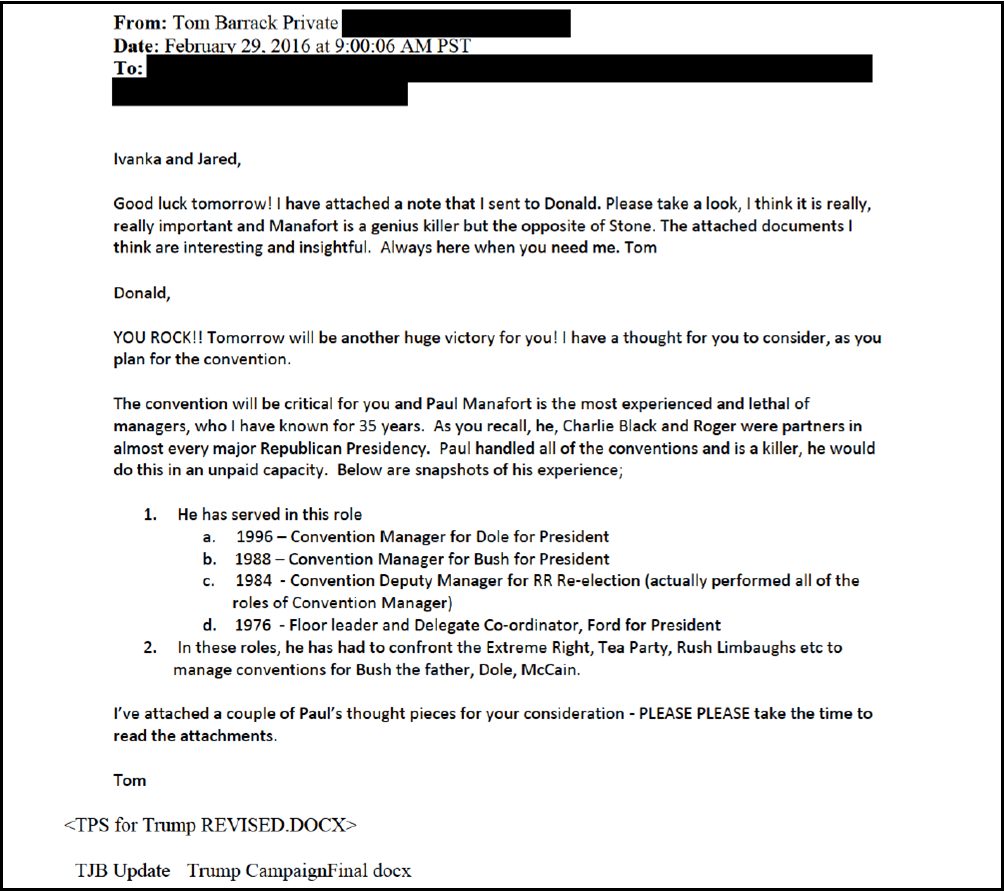

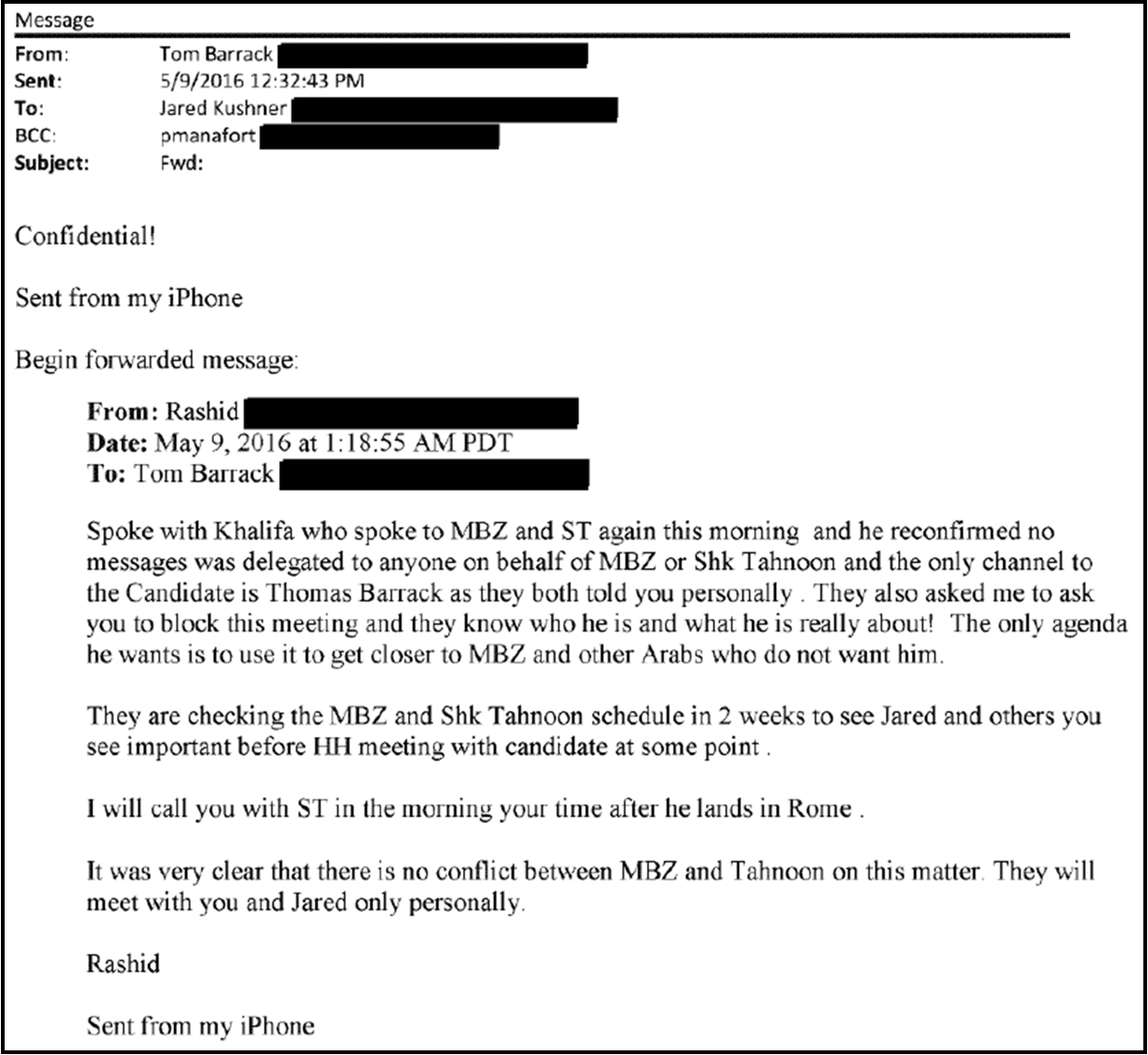

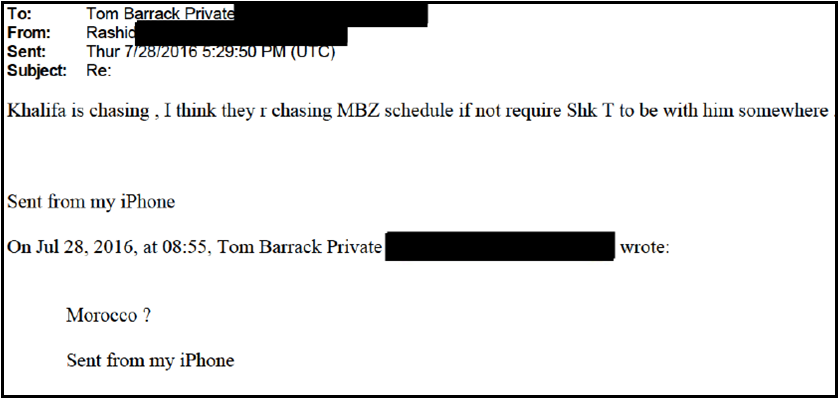
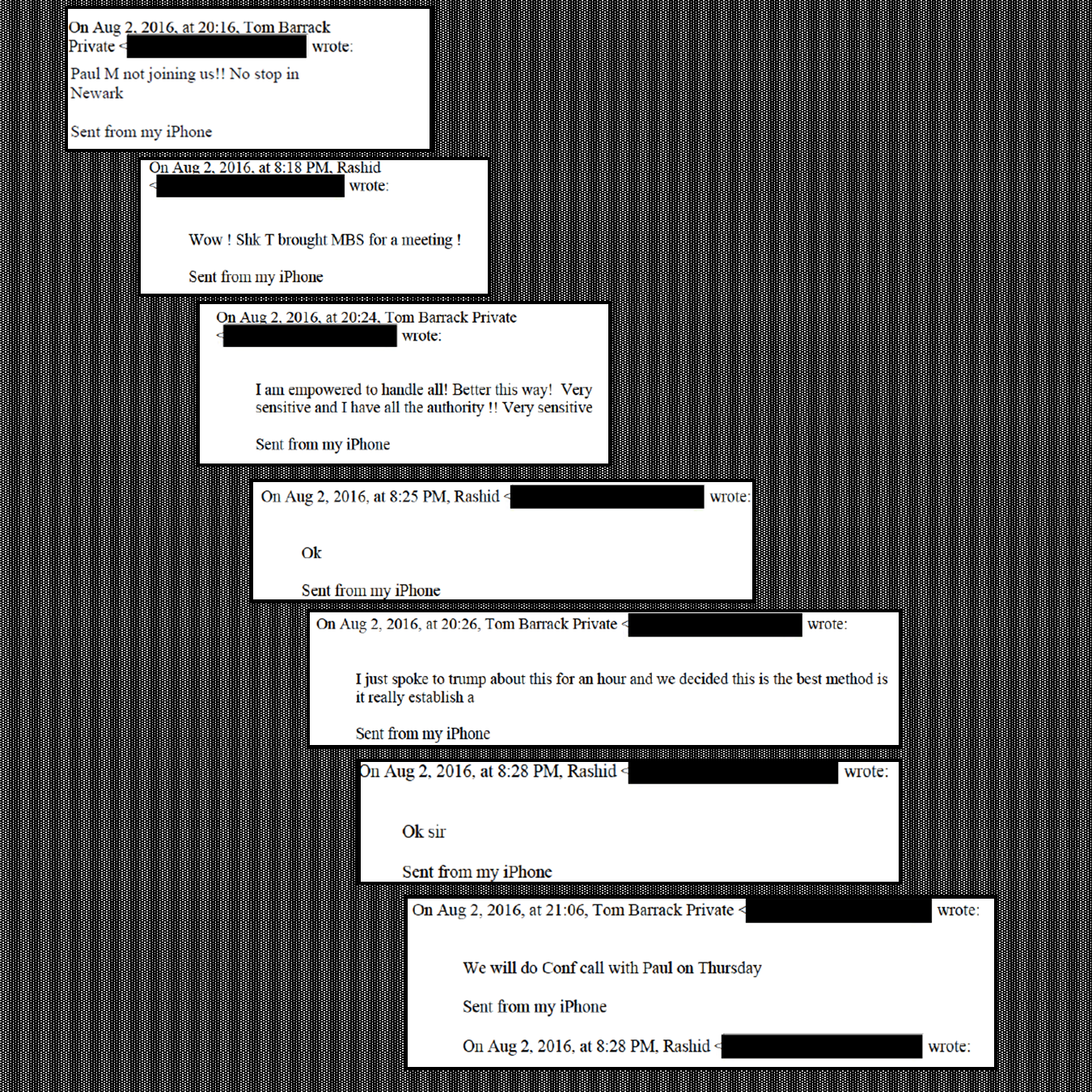


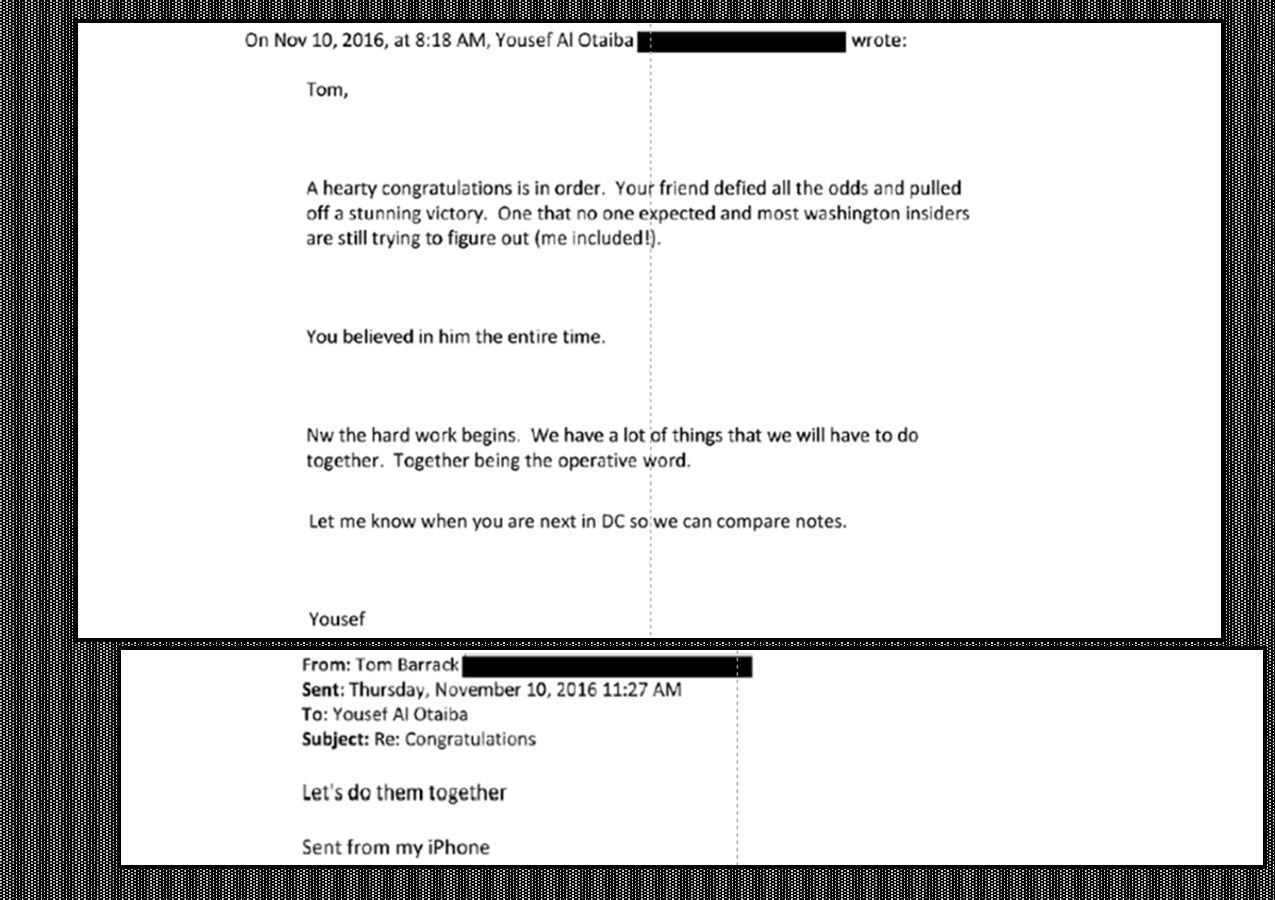
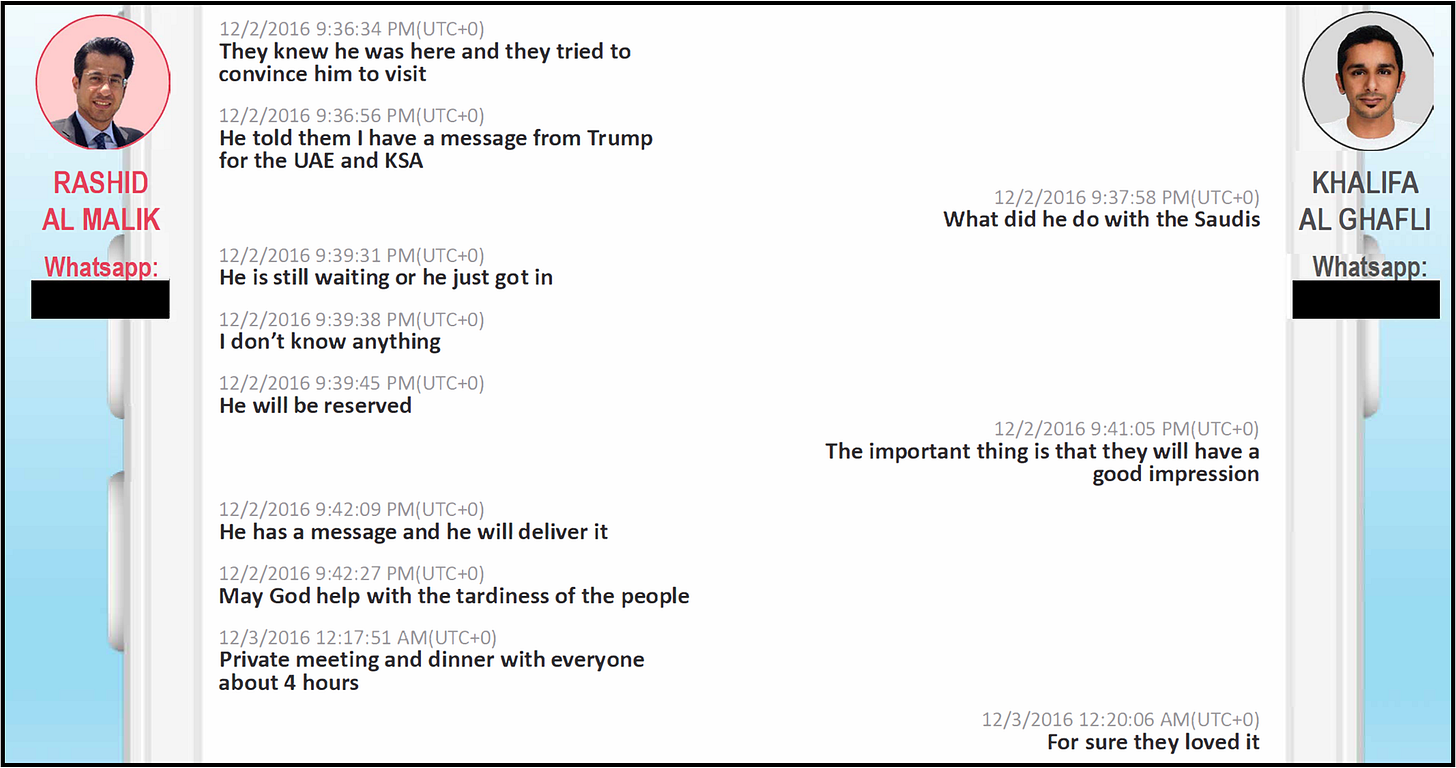

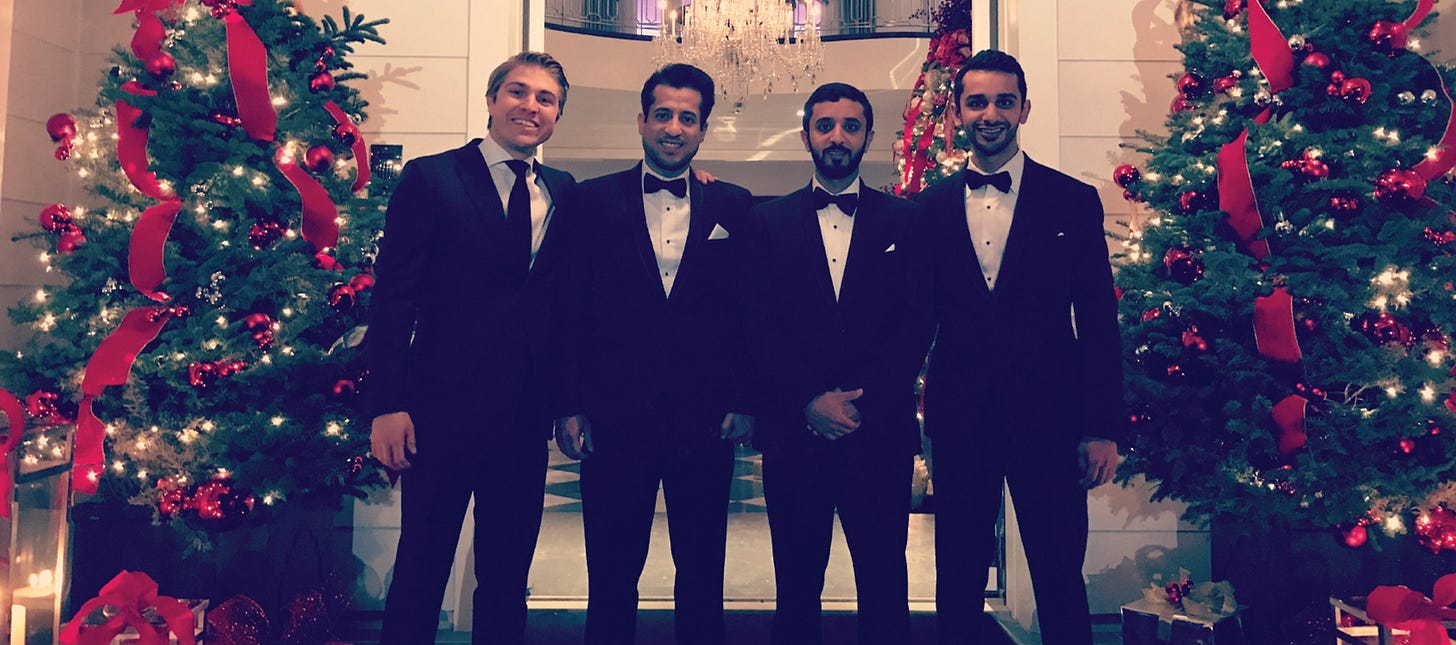
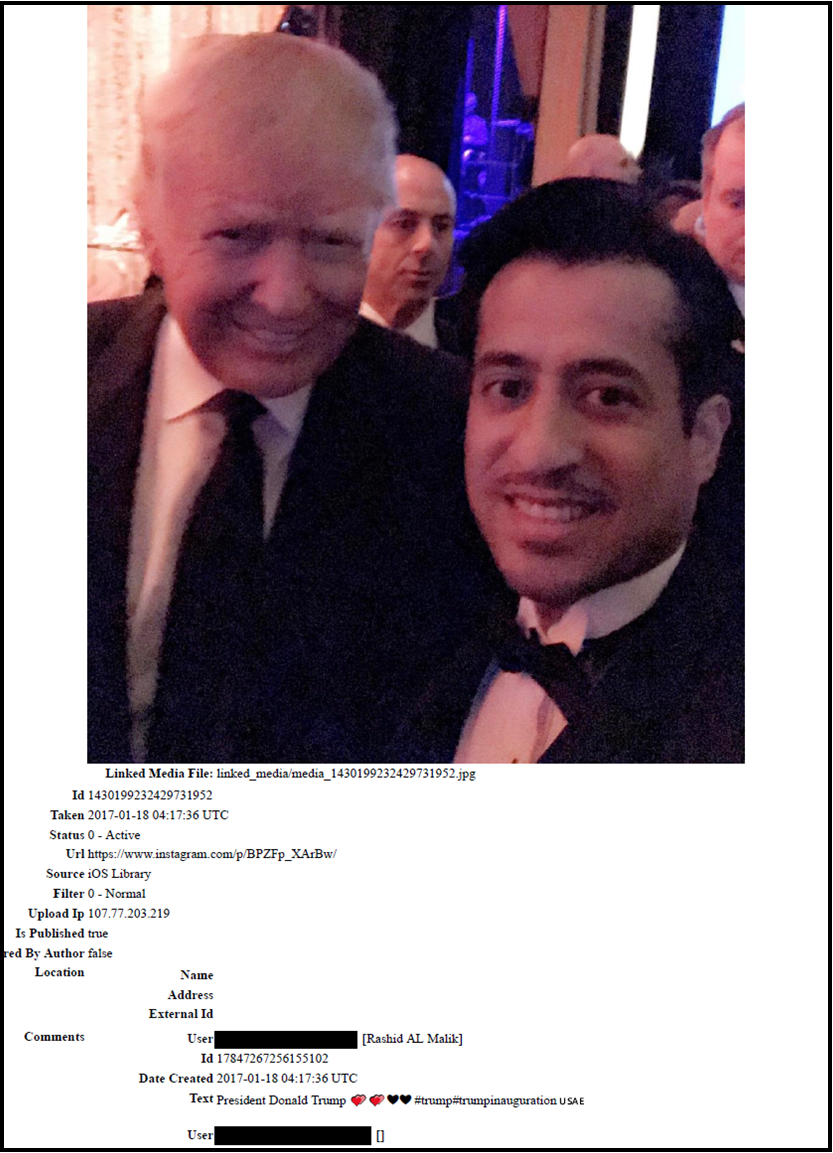
Great work